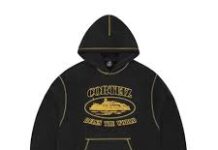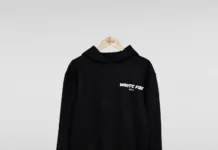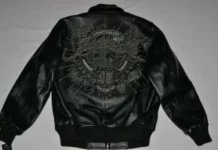In the fast-paced world of streetwear, authenticity and storytelling are what separate true culture-driven brands from the rest. One of the most talked-about and emerging names in this space is Hellstar, a brand that blends bold symbolism, underground aesthetics, and spiritual undertones with classic streetwear staples. From its mysterious branding to its cult-like following, Hellstar is not just a clothing label—it’s a movement of identity, energy, and rebellion.
While relatively young, Hellstar has grown rapidly thanks to its powerful visual language and support from the hip-hop, sports, and fashion communities. The brand’s signature graphic-heavy hoodies, tees, and tracksuits have become recognizable symbols in the world of contemporary streetwear, reflecting a deeper narrative beyond mere fashion.
The Origins of Hellstar
Hellstar was founded in the early 2020s by Sean Holland and a group of creatives with backgrounds in design, music, and youth culture. Based in the United States—particularly inspired by the creative scenes of Los Angeles and New York—the brand came to life as a way of expressing a unique worldview: that life is a balance between light and darkness, heaven and hell, peace and chaos.
The name “Hellstar” itself is an intentional paradox. It speaks to the idea that everyone has a light inside them, even when surrounded by darkness. It resonates with a generation that has grown up navigating mental health struggles, social unrest, and the tension between self-expression and societal expectations.
The Aesthetic: Dark, Spiritual, and Electric
Hellstar’s visual identity is unmistakable. The brand leans into themes of spiritual warfare, celestial energy, and cosmic symbolism, all delivered through gritty graphics, gothic typography, and aggressive design elements.
Key features of Hellstar designs:
- Heavy graphic use: Flames, skulls, stars, crosses, and otherworldly elements dominate many designs.
- Spiritual slogans: Phrases like “Heaven Sent,” “Out of Darkness Comes Light,” and “Hellstar World” appear on hoodies and tees.
- Bold colorways: Black, red, purple, and metallic silvers are common, often contrasted with neon or reflective inks.
- Washed and vintage finishes: Giving pieces an aged, lived-in look, enhancing the underground appeal.
- Premium fabrics: Oversized fits and heavyweight cotton make the garments feel substantial and luxurious while still rooted in streetwear.
Hellstar clothing stands out not because it’s overly flashy but because it feels charged with meaning. Each piece tells a story—about struggle, self-discovery, and transformation.
Signature Pieces
Hellstar Clothing has released several standout items that have helped define its aesthetic and fuel its popularity.
1. Hellstar Hoodies
The brand’s most popular item. Featuring large back prints, spiritual graphics, and a relaxed fit, the hoodie is often the centerpiece of each drop. It’s become a go-to item for rappers, athletes, and fashion influencers alike.
2. Graphic T-Shirts
Often released in washed vintage styles, these tees carry bold statements and visually dense artwork, making them favorites for layering or standalone looks.
3. Tracksuits and Shorts
In addition to tops, Hellstar has expanded into techwear-inspired pants, matching sets, and sport-style silhouettes that blend luxury and comfort.
4. Accessories and Limited Drops
From beanies to trucker hats and socks, Hellstar has built a full lifestyle collection, keeping each item in short supply to increase demand and exclusivity.
Marketing Strategy: Scarcity and Community
Much like fellow underground streetwear brands (such as Corteiz or Gallery Dept.), Hellstar thrives on limited-edition drops, creating a sense of urgency and exclusivity.
Core elements of Hellstar’s marketing:
- Drop Culture: Hellstar announces new collections via Instagram with short notice, selling out items quickly to maintain hype.
- Celebrity Wearers: Without traditional advertising, Hellstar gains exposure through artists like Lil Baby, Lil Durk, Travis Scott, Offset, and James Harden, who have all been seen rocking Hellstar fits.
- Mystery and Minimalism: The brand rarely gives interviews or over-explains its meaning, leaving much of the mystique to be interpreted by the audience.
- Collabs and Pop-Ups: Hellstar has teased collaborative releases and exclusive pop-up events, keeping fans engaged and building a deeper connection with the brand.
This method of organic growth ensures Hellstar remains true to its roots while expanding its reach.
Cultural Relevance and Symbolism
What makes Hellstar so impactful isn’t just its visuals—it’s what the visuals represent. In an age where young people are looking for meaning in everything they wear, Hellstar provides a layered narrative.
Themes reflected in Hellstar apparel:
- Light vs. Darkness: Many pieces play with duality, symbolizing the internal struggles between good and evil.
- Spiritual Awakening: Graphics often include references to celestial beings, energy fields, and cosmic rebirth.
- Mental Health and Identity: The brand reflects a mood—one of self-searching, resistance, and the will to overcome.
Hellstar taps into the emotional and spiritual journey many young people face, making it feel less like a brand and more like a philosophy. That’s why it’s resonating far beyond the fashion world—it’s a symbol of personal power.
The Celebrity Effect
Without paying for traditional marketing, Hellstar has become a favorite among celebrities and athletes. Key figures who have helped boost its visibility include:
- Drake – Worn Hellstar hoodies in casual appearances.
- Lil Baby & Lil Durk – Regularly seen in the brand on tour and in music videos.
- James Harden – Showcased Hellstar fits in pre-game NBA tunnel walks.
- Kaytranada, A$AP Mob members, and Brent Faiyaz – Helped give the brand high-fashion credibility without making it feel corporate.
These organic co-signs have amplified Hellstar’s reach while keeping its credibility intact.
Challenges and Opportunities
As Hellstar’s popularity rises, it faces the same tension as all underground brands: how to scale without selling out. Fans love the brand for its exclusivity and depth—too much exposure could threaten that balance.
Key challenges ahead:
- Maintaining authenticity while growing distribution
- Avoiding overproduction and resale inflation
- Expanding global reach without diluting brand identity
However, Hellstar also has massive potential to become a mainstay in global streetwear. Its layered symbolism, premium design, and emotional resonance position it for success across apparel, accessories, and even media or spiritual-themed storytelling projects.
The Future of Hellstar
As of now, Hellstar continues to build quietly but powerfully, expanding its collections, teasing collaborations, and capturing the hearts of fans who see fashion as an extension of their inner world.
What started as a clothing brand is fast becoming a cultural movement—one that speaks to the light, the dark, and everything in between. With its bold identity and strong storytelling, Hellstar is on track to burn even brighter in the coming years.
Conclusion
Hellstar is more than just hoodies and flame graphics. It’s a brand that dares to be spiritual, emotional, and fearless in a world that often prefers surface over depth. By embracing cosmic symbolism, underground ethos, and limited-access drops, Hellstar has carved out a space where fashion and philosophy meet.
For a generation looking for deeper meaning in their clothes, Hellstar delivers not just style—but soul.































